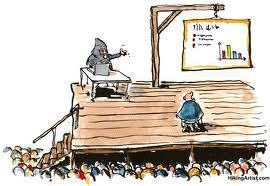Killing them Softly with PowerPoint? Wake them up with Whiteboarding!
 We’ve all heard the term “death by PowerPoint,” or worse, experienced it. It refers to the lack of interactivity and boredom engendered by the typical slide presentation. The term invokes an arresting image that reminds us that, if you want to engage your audience while standing out from your competitors, slides aren’t the answer.
We’ve all heard the term “death by PowerPoint,” or worse, experienced it. It refers to the lack of interactivity and boredom engendered by the typical slide presentation. The term invokes an arresting image that reminds us that, if you want to engage your audience while standing out from your competitors, slides aren’t the answer.
In this post, we’ll look at five ways salespeople can boost performance using “visual storytelling” instead of slides. Whether using a whiteboard, a flip chart, the back of an envelope or a tablet PC via desktop sharing software, you can integrate the visual storytelling model into your existing sales methodology and apply the approach as a powerful differentiator in competitive and complex selling environments.
Five Ways to Tell Your Story Visually
1. Develop a Powerful Whiteboard “Story” Instead of Bullet Points
Your presentation should be much more than just a list of bullets – it should be a compelling visual narrative designed to showcase your products and services and how they deliver unique value. For example, you could create a story about a tragic hero (an anonymous customer) who overcomes adversity (the current situation) to attain ultimate glory (the desired state, achieved uniquely by your solution/service).
The story also needs to be visually intriguing, with humorous iconography, and should have a script that goes along with each step. The whiteboard story should include planned “interaction points” where you’ll engage with the customer to ensure a two-way dialogue. Stay away from features and benefits. Instead, ask and help answer these specific questions: what’s the impact of sticking with the status quo, and what’s the value of making a change?
2. Stick Figures are More Powerful than Photography
One way people have attempted to fix the PowerPoint problem is by using large photographs and metaphorical imagery with just a few words on the slides. While this may help make a keynote speech more interesting, it doesn’t advance the cause in a sales cycle, make abstract ideas more concrete, or make complex concepts simpler.
Stick figures and symbols get it done – boxes, circles, arrows, dollar signs…stuff you can draw. Even more importantly, these hand-drawn visuals can be redrawn by your prospects after you leave the room. You want your story to “walk the halls” in your absence, right? You want your prospect to feel smarter and more empowered to promote your story? Well then, give them the gift of a simple story and visual that helps them understand and react, as well as own and distribute.
3. Visual Storytellers are More Consultative
With the visual storytelling approach, it’s essential that you immerse yourself in the content. Prospects perceive salespeople with a clicker in their hand as “PowerPoint jockeys.” You are telling a story that someone else created. A visual story that you draw, and explain along the way, gives you the credibility. It confers the knowledge and expertise to you, not the marketing department that created the pretty slides.
In a world where every salesperson wants to appear as a trusted advisor or practice consultative selling, visual storytellers are seen as adding more value, facilitating more engagement, and delivering insight and expertise. Storytellers get the room to think about their challenges and opportunities in a fresh and interactive way. Turning on the lights and taking a pen in your hand, as opposed to closing the shades and standing in the shadows of the LCD panel, create an entirely different perception of you and the role you are playing in the room.
4. Create a Sticky Virtual Experience
If you’re part of an inside sales team, or spend much of your sales cycle dealing with prospects over the Web and on the phone, visual storytelling can create a huge point of differentiation. Just because you aren’t face-to-face with the customer doesn’t mean you can’t use whiteboarding techniques.
Using simple Web conferencing software and an inexpensive pen tablet, you can easily simulate a full whiteboarding experience. This can be the difference between creating a remarkable and memorable sales experience, and sounding and looking like everyone else.
We’ve found that while 50 percent of WebEx viewers intermittently leave a remotely shared PowerPoint presentation to access other applications, the attrition rate is less than 10 percent using the visual storytelling approach.
5. A Whiteboarding Methodology
Great visual stories don’t happen spontaneously. They are pre-built based on the different moments of truth in the customer buying cycle. At the beginning, you need to answer the foremost question in the prospect’s mind: why should I change? You need a whiteboard that helps them see why their status quo isn’t safe and why they need to consider doing something different.
The next question you need to answer is: why you? For that you need a visual story that clearly delineates your differences and strengths in contrast to the status quo and the competitive alternatives. Finally, you need to address the question: why now? That calls for a visual story that presents the business case and a relevant example of how someone achieved their desired outcomes and realized the projected value.
Each of these is a different, complementary whiteboard that builds on the previous one and develops your story along the decision-making path.
The Reality
Having a good sales process is important, but having something truly provocative to say when you actually interact is essential. Visual storytelling is the fuel that powers your sales process engine.
Filed under: Business-to-Business, Deliver Conversations that Win, Sales Tagged: death by PowerPoint, PowerPoint, presentation skills, sales, visual storytelling, whiteboarding

Timothy Riesterer's Blog
- Timothy Riesterer's profile
- 3 followers



